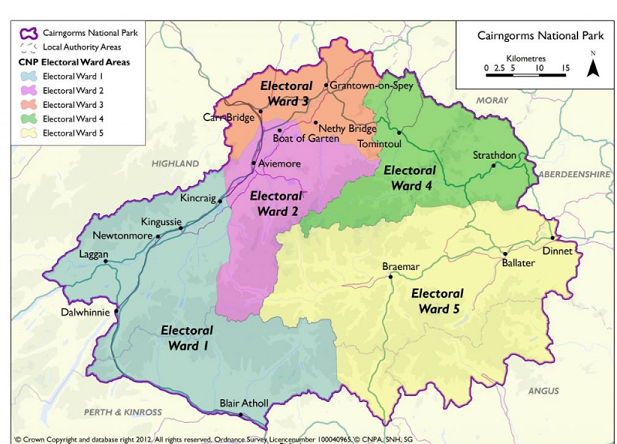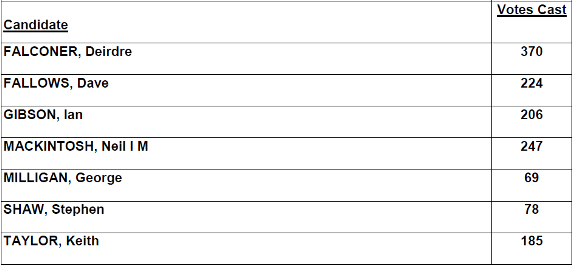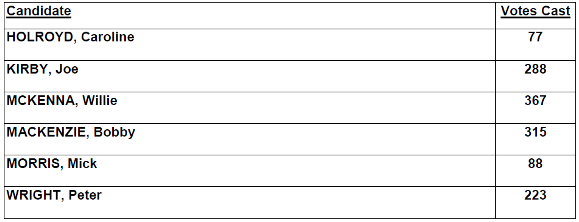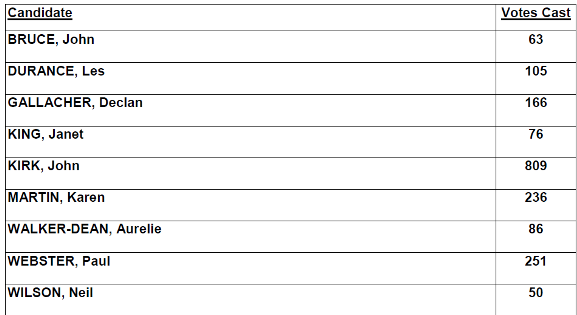Scotland has fewer democratically elected representatives and a more centralised system of government than anywhere else in Europe, including England (see here) and (here). More and more power is exercised directly by the Scottish Government, . While the Scottish Parliament has, since it was set up, reviewed or created a number of new Public Authorities, the Boards of almost of all these are directly appointed by Scottish Ministers and are increasingly told what to do by civil servants. Our National Park Authorities are unique in that about a third of their Board Members are directly elected by local communities, while another third, while appointed by Scottish Ministers are nominated by Local Authorities. This means that our National Park Authorities, through the way their Boards are elected, in theory have a degree of independence lacking in other Public Authorities.
In practice, the ability of our National Parks to act independently, has been seriously constrained. This has been partly through their budgets being controlled by the Scottish Government – if they don’t focus on the objectives “agreed” with the Scottish Government they risk their budgets being cut – and through the appointment of Board Members who will tow the party line. Hence why the Loch Lomond and Trossachs National Park Authority has wasted three years acting like a camping management authority, rather than a National Park, and is promoting Flamingo Land. Its also, however, been because our National Parks’ democratically elected members have lacked legitimacy and as a consequence, in the LLTNPA at least, treated as second class Board Members. It was most welcome therefore that the CNPA devoted more effort than ever before to promoting the direct elections which took place in March (see here) and (here) .
So what do the election results, which the Park Authority announced in a brief News Release on 29th March, tell us about the state of democracy in the National Park? And what are the implications?
Candidates and voter participation

While there were 25 candidates over the 5 wards, matching the number of people who stood for the Board when the Park was set up in 2003, average turnout was still just 41%. This was despite the postal ballot which should make voting easier.
While turnout was significantly up on than in 2015, where one ward was uncontested and three had a turnout of under 30% (see here), it was still – despite CNPA’s efforts to promote the elections – far lower than it was just 15 years ago.

The highest turnout this year was in Ward 5, where there were just two candidates, at 44.25%. This was lower than any ward polled back in 2003 and lower than three wards in 2007 and 2011 and down from the 47.4% polled in 2015. In fact, apart from in 2015, this was the lowest level of voter participation that has been recorded in the National Park. The increase in the number of candidates on the Western side of the Park appears to have had almost no impact on voter turnout. The question the CNPA now needs to ask is why?
I would suggest there are two factors that could have influenced turnout. The first is that people who live within the Cairngorms National Park simply don’t see the Park Authority as being relevant to their lives or that voting makes much difference. This perception was reinforced by the CNPA briefing for people interested in standing for the Board in which it was apparently claimed that the role of local Board Members, once elected, was NOT to represent the electorate but to act act on behalf of Scottish Ministers. The Loch Lomond and Trossachs National Park Authority has taken a similar line. This has prevented locally elected members speaking out. Its no wonder that as a result that much of the local electorate see little point in voting. There appears to be NO legal justification for this attempt to constrain locally elected members. The Schedule to the National Park’s Act (see here) clearly differentiates between locally elected members and other members appointed by Scottish Ministers and places NO constraints on them. Furthermore it makes it clear that “A National Park authority—(a) is not to be regarded as a servant or agent of the Crown” – despite the best efforts of the Scottish Civil Service over the last 15 years.
The second factor that influences turnout is that’s its very difficult for electors to establish the differences between candidates. While Candidate Statements were circulated with the voting papers – (see here) and (here) for example – generally they are not that helpful. The emphasis, with a couple of exceptions, is on the candidates experience and knowledge of the area rather than what they would do let alone what they would like to change. The statements rather reminded me of the elections for voluntary organisations like the National Trust for Scotland where it becomes almost impossible to know what you are voting for. As a consequence, unless you know of a candidate through other channels it becomes very difficult to know how to cast your vote This is something the CNPA needs to address. Could it for example support community councils in future to hold election hustings (which in my experience do enable the differences between candidates to become clearer)?
The unfair electoral system
Last year I highlighted how, in the Loch Lomond and Trossachs National Park Authority (see here) one local member was elected on just 17% of the vote. It was not quite that bad in the Cairngorms National Park Authority but two members were elected with just over 25% of the vote and were supported by just over 10% of the local electorate.
| Candidates | Electorate | Voted | Turnout | Votes for winning candidate | % votes cast | % total voters for winning candidate | |
| Ward 1 | 7 | 3598 | 1385 | 38.49 | 370 | 26.71% | 10.28% |
| Ward 2 | 6 | 3356 | 1358 | 40.46 | 367 | 27.02% | 10.93% |
| Ward 3 | 9 | 4257 | 1848 | 43.41 | 809 | 43.77% | 19% |
| Ward 4 | 1 | 956 (2015) | 0 | 0 | 0 | 0 | 0 |
| Ward 5 | 2 | 2323 | 1028 | 44.25 | 592 | 57.58% | 25.48% |
That is not good for democracy. These results, in my view, should prompt reform of the voting system in our National Parks and for Scottish Ministers to introduce the Single Transferrable voting system BEFORE the next elections.
The results ward by ward
While the CNPA news release announced that the elections had resulted in two new Board Members, only one existing Board Member was defeated.

In Ward 1 Dave Fallows was beaten into third place. I know nothing about the winning candidate, Deirdre Falconer but Dave Fallows (whom I have never met) a landscape artist was the Board Member who had been most prepared to speak out for the landscape in the National Park. He led the Board opposition to the recommendations of officers on both the Dry Ski Slope at Cairn Gorm and the Balavil Hill track – illustrating the important role that independently minded locally elected members can play. Its unclear whether any of the elected members will take on that role. While Deirdre Falconer had a small majority under the first past the post system another candidate might well have been elected under the STV system.

In Ward 2 Willie McKenna was once again elected to the Board but by a very small majority. He has been on the Board since his inception. In democratic terms, this raises two issues. Should there be a limit to the number of times that someone can stand for a Public Authority Board? And did the number of opposition candidates split the vote against him?

In Ward 3, John Kirk, had a much bigger majority and much larger share of the total vote and as a consequence it appears fairly likely that he would also have been elected under an STV system. One reason for this is that he appears to have gained quite a high profile locally from having campaigned against Scottish Water (see here).
Ward 4, whose electorate is less than a quarter of neighbouring Ward 3, is an anomaly. Just why people are no longer standing there is unclear but the case for reviewing the ward boundaries appears very strong.
The election in Ward 5 involved two fairly well known candidates, Geva Blackett and Eric Baird, both with connections to large estates (invercauld and Glen Tanar) but with different views. That possibly explains why it had the highest turnout. It produced what was probably the fairest election result, with Geva Blackett being the only candidate to win over 50% of the vote though even then that represented only 25% of the electorate.
A consequence of these results is that there is NO locally elected member who has a really strong democratic mandate. That weakens them all.
What needs to happen
The Convener of the CNPA, Xander McDade, made considerable efforts to encourage more people to stand in these elections. While this is to welcomed, it only had limited impact. There is something very wrong with our democracy where in one ward a member is elected unopposed. In terms of numbers of candidates, a significant division appears to have appeared between the east and west side of the Park and the sheer number of candidates on the west had exposed the unfairness of the first past the post voting system.
After the LLTNPA elections, I suggested that the LLTNPA Board needed to review the electoral system and make recommendations to Scottish Ministers. They never did so. I hope that the CNPA will now do so as they did back in 2011 (see here) and that even members who may have benefitted from the unfair electoral system will support this. We need public authorities who are prepared to make the case for better local democracy.
Scottish Ministers, however, also have a responsibility here. There has never been a proper review of the electoral system in our National Parks. I discovered recently that the reason the limit on election expenses is only £100 in the LLTNPA but £250 in the CNPA dates back to the separate election orders made in 2002/2003. The difference is completely unjustifiable and neither amount has been uprated since then to take account of inflation. Perhaps Mairi Gougeon, the newish Minister for the Environment, will take more interest in fostering democracy in our National Parks then her predecessors? She should do, her constituency takes in part of the Angus Glens.
Your article raises many very pertinent questions, Nick. In particular, the single transferable vote system needs to be introduced – even in general elections! In my Ward, there were a few candidates I would have been happy to vote for, but could only vote for one. As you say, the STV system also avoids splitting voting against a particular candidate, and for these reasons is much more democratic.
I likewise am concerned about apathy towards the National Parks by voters. One way of reducing apathy is to stop having any candidates nominated by the Scottish Government. To many this just looks like jobs for friends and the same people often crop up in various Scottish Government supported quangos. People living in National Parks need to feel a greater sense of ownership of the Park they live in.
The problem, as is so often the case, is that the people in power just don’t seem to be listening. Why should the Scottish Government try to consult on and consider the changes you suggest? I believe it suits the Scottish Government to leave things as they are so that they can continue to exert the greatest influence, get their own way and stay within their ‘comfort blankets’.